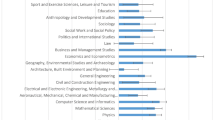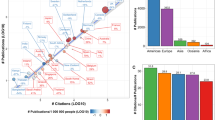Abstract
Publication and citation data for the thirty journals listed in the Dermatology & VenerealDiseases category of the 1996 edition of the Journal Citation Reports (JCR) on CDROM andseven dermatology journals not listed in the JCR-1996 were retrieved online from DIMDI andanalysed with respect to short- and long-term impact factors, ratios of cited to uncited papers, aswell as knowledge export and international visibility.
The short-term impact factors (calculated according to the rules applied in the JCR) are verysimiliar to their JCR counterparts; thus there are only minor changes in the rankings according toJCR impact factors and those calculated on the basis of online data. The non-JCR journals rankwithin the upper (two titles) and the lower third of the 37 journals (one title being at the upper endof the last third and the other four titles being at the very end of the list). Ranking the journalsaccording to their long-term impact factors results in no major changes of a journal's position.Normalized mean citation rates which give a more direct impression of a journals's citedness inrelation to the average citedness of its subfield are also shown.
Ratios of cited to uncited papers parallel in general the impact factors, i.e., journals withhigher (constructed) impact factors have a higher percentage of cited papers. For each journal, theGini concentration coefficient was calculated as a measure of unevenness of the citationdistribution. In general, journals with higher (constructed) impact factors have higher Ginicoefficients, i.e., the higher the impact factors the more uneven the citation distribution.
Knowledge export and international visibility were measured by determination of the distinctcategories to which the citing journals have been assigned ("citing subfields") and of the distinctcountries to which the citing authors belong ("citing countries"), respectively. Each journalexhibits a characteristic profile of citing subfields and citing countries. Normalized rankingsbased on knowledge export and international visibility (relating the number of published papers tothe number of distinct subfields and distinct countries) are to a large extent different compared tothe impact factor rankings. It is concluded that the additional data given, especially the data onknowledge export and international visibility, are necessary ingredients of a comprehensivedescription of a journal's significance and its position within its subject category.
Similar content being viewed by others
References
E. FrÖmter, E. BrÄhler, U. Langenbeck, N. M. Meenen, K. H. Usadel, Das AWMF-Modell zur Evaluierung publizierter Forschungsbeiträge in der Medizin, Deutsche medizinische Wochenschrift, 124 (1999) 910-915.
J. Spaventi, N. Tudor-Šilovic, S. Maricic, M. Labus, Bibliometrijska analiza znanstvenih casopisa iz Jugoslavije (Bibliometric analysis of scientific journals from Yugoslavia), Informatologia Yugoslavica, 11 (1979) 11-23.
B. K. Sen, A. Karanjai, U. M. Munshi, A method for determining the impact factor of a non-SCI journal, Journal of Documentation, 45 (1989) 139-141.
F. H. Christensen, P. Ingwersen, Online citation analysis. A methodological approach, Scientometrics, 37 (1996) 39-62.
F. H. Christensen, P. Ingwersen, I. Wormell, Online determination of the journal impact factor and its international properties, Scientometrics, 40 (1997) 529-540.
J. Stegmann, How to evaluate journal impact factors, Nature, 390 (1997) 550.
J. Stegmann, Building a list of journals with constructed impact factors, Journal of Documentation, 55 (1999) 310-324.
D. Schoonbaert, G. Roelants, Impact takes precedence over interest, Nature, 391 (1998) 222.
H. F. Moed, T.N. Van Leeuwen, J. Reedijk, Towards appropriate indicators of journal impact, Scientometrics, 46 (1999) 575-589.
I. Wormell, Informetric analysis of the international impact of scientific journals: how 'international' are the international journals? Journal of Documentation, 54 (1998) 584-605.
T. Braun, W. GlÄnzel, United Germany: the new scientific superpower? Scientometrics, 19 (1990) 513-521.
R. Rousseau, Evenness as a descriptive parameter for department or faculty evaluation studies, In: E. DE SMET (Ed.), Informatiewetenschap 1998, Werkgemeenschap Informatiewetenschap, Antwerpen, 1998, pp. 135-145.
R. Rousseau, Concentration and evenness measures as macro-level scientometric indicators, Second International Seminar on Quantitative Evaluation of Research Performance, Shanghai, 2000.
INSTITUTE FOR SCIENTIFIC INFORMATION, Journal Citation Reports on CD-ROM (Science Edition), 1996.
INSTITUTE FOR SCIENTIFIC INFORMATION, Journal Citation Reports on CD-ROM (Science Edition), 1999.
INSTITUTE FOR SCIENTIFIC INFORMATION, Journal Citation Reports on CD-ROM (Science Edition), 1997.
INSTITUTE FOR SCIENTIFIC INFORMATION, Journal Citation Reports on CD-ROM (Science Edition), 1995.
A. M. Ramirez, E. O. Garcia, J. A. Del Rio, Renormalized impact factor, Scientometrics, 47 (2000) 3-9.
A. Solari, M. H. Magri, A new approach to the SCI Journal Citation Reports, a system for evaluating scientific journals, Scientometrics, 47 (2000) 605-625.
G. Van Hooydonk, R. Gevaert, G. Mili-Proost, H. Van De Sompel, K. Debackere, A bibliotheconomic analysis of the impact factors of scientific disciplines, Scientometrics, 30 (1994) 65-81.
P. O. Seglen, The skewness of science, Journal of the American Society for Information Science, 43 (1992) 628-638.
P. O. Seglen, Citations and journal impact factors: questionable indicators of research quality, Allergy, 52 (1997) 1050-1056.
P. Ingwersen, B. Larsen, I. Wormell, Applying diachronic citation analysis to ongoing research program evaluations, In: B. Cronin, H. B. Atkins (Eds), The Web of Knowledge: A Festschrift in Honor of Eugene Garfield, Information Today Inc., Medford, 2000, pp. 373-387.
R. Rousseau, G. Van Hooydonk, Journal production and journal impact factors, Journal of the American Society for Information Science, 47 (1996) 775-780.
R. J. W. Tijssen, T. N. Van Leeuwen, On generalising scientometric journal mapping beyond ISI's journal and citation databases, Scientometrics, 33 (1995) 93-116.
J. Stegmann, Significance of journals not listed in the Journal Citation Reports (JCR), Proceedings of the 8th International Congress on Medical Librarianship, London, 2nd–5th July 2000, [Online]. Available: http://www.icml.org/tuesday/ir/stegmann.pdf (July 2000).
R. N. Kostoff, Citation analysis cross-field normalization: A new paradigm, Scientometrics, 39 (1997) 225-230.
Author information
Authors and Affiliations
Rights and permissions
About this article
Cite this article
Stegmann, J., Grohmann, G. Citation rates, knowledge export and international visibility of dermatology journals listed and not listed in theJournal Citation Reports. Scientometrics 50, 483–502 (2001). https://doi.org/10.1023/A:1010562815788
Issue Date:
DOI: https://doi.org/10.1023/A:1010562815788




